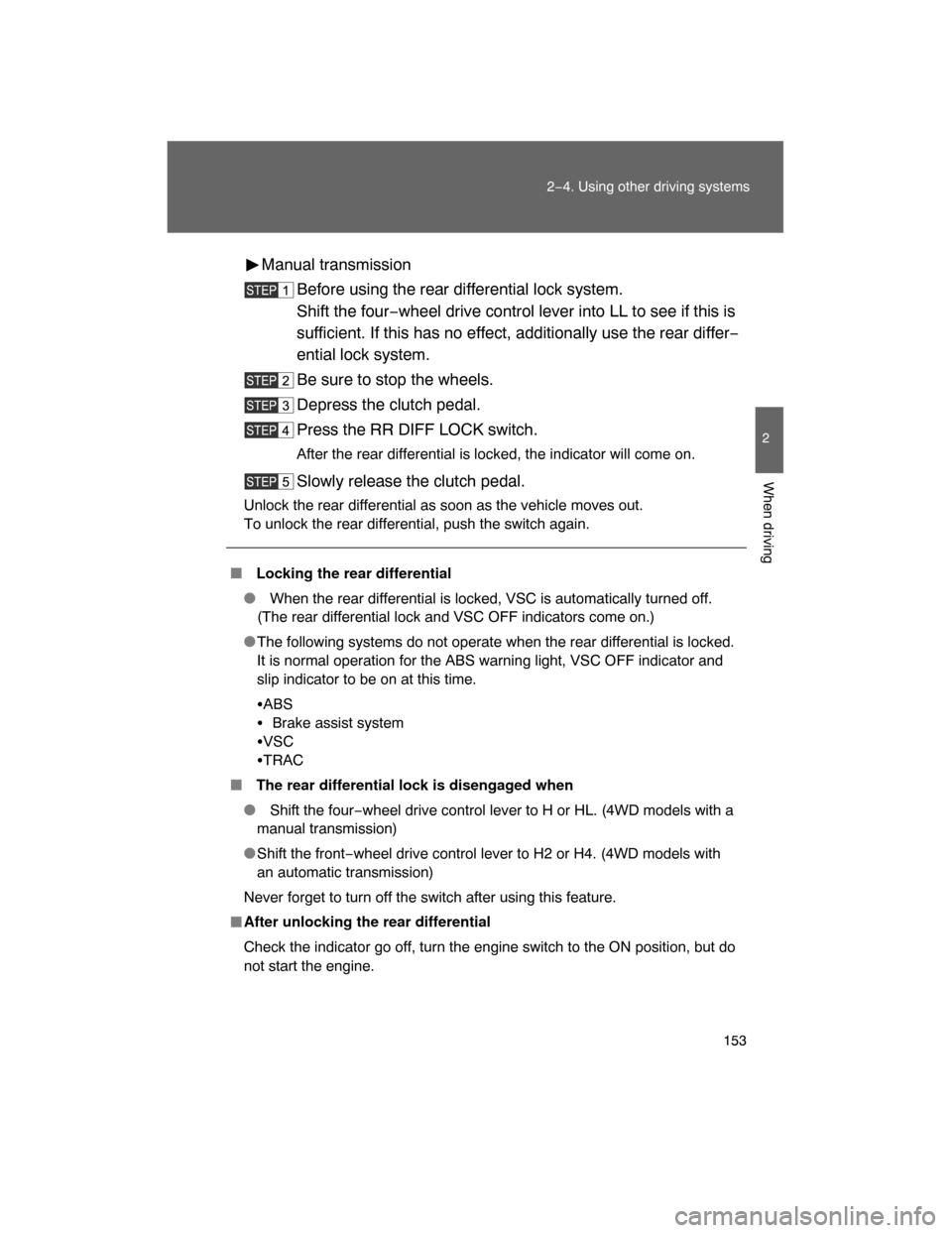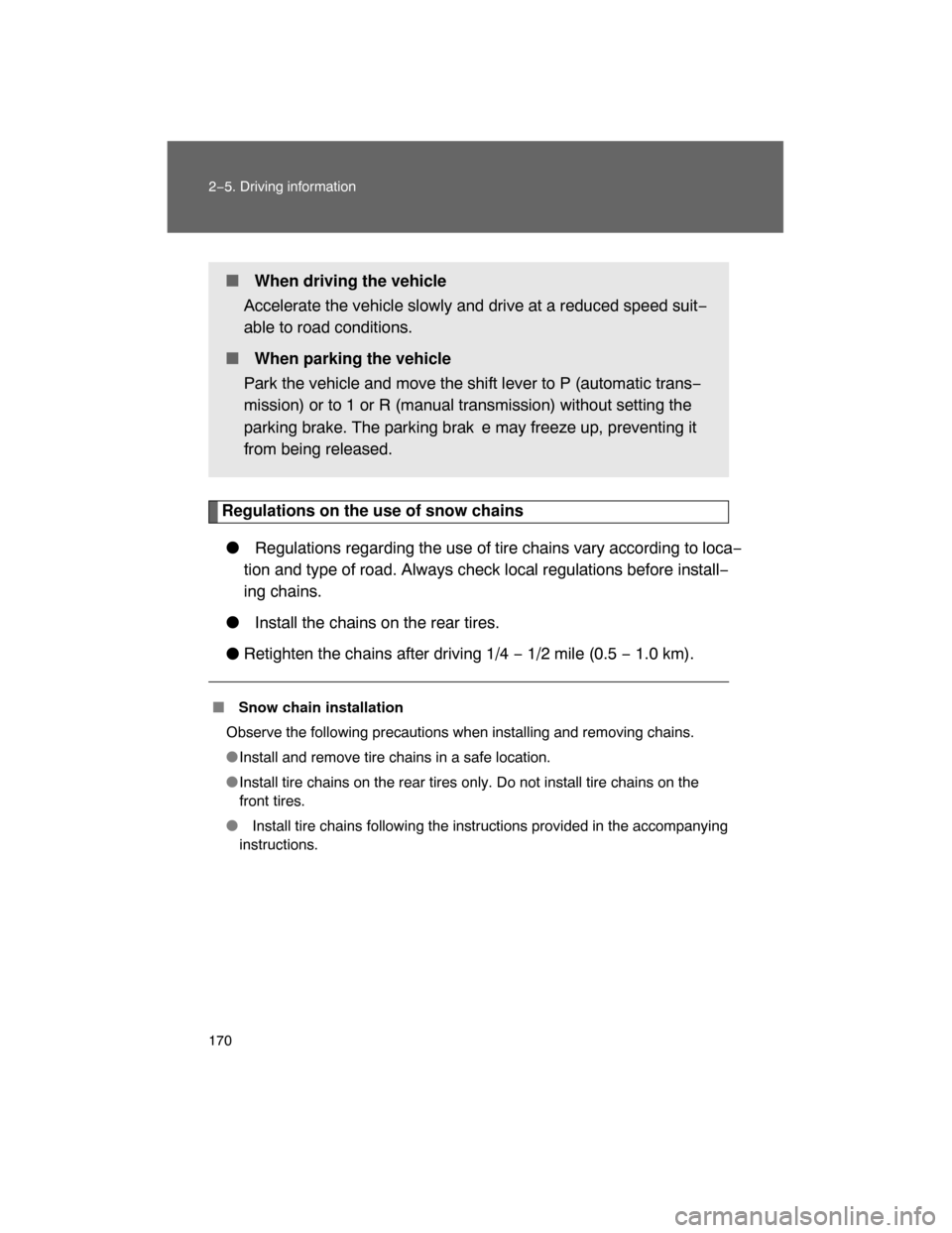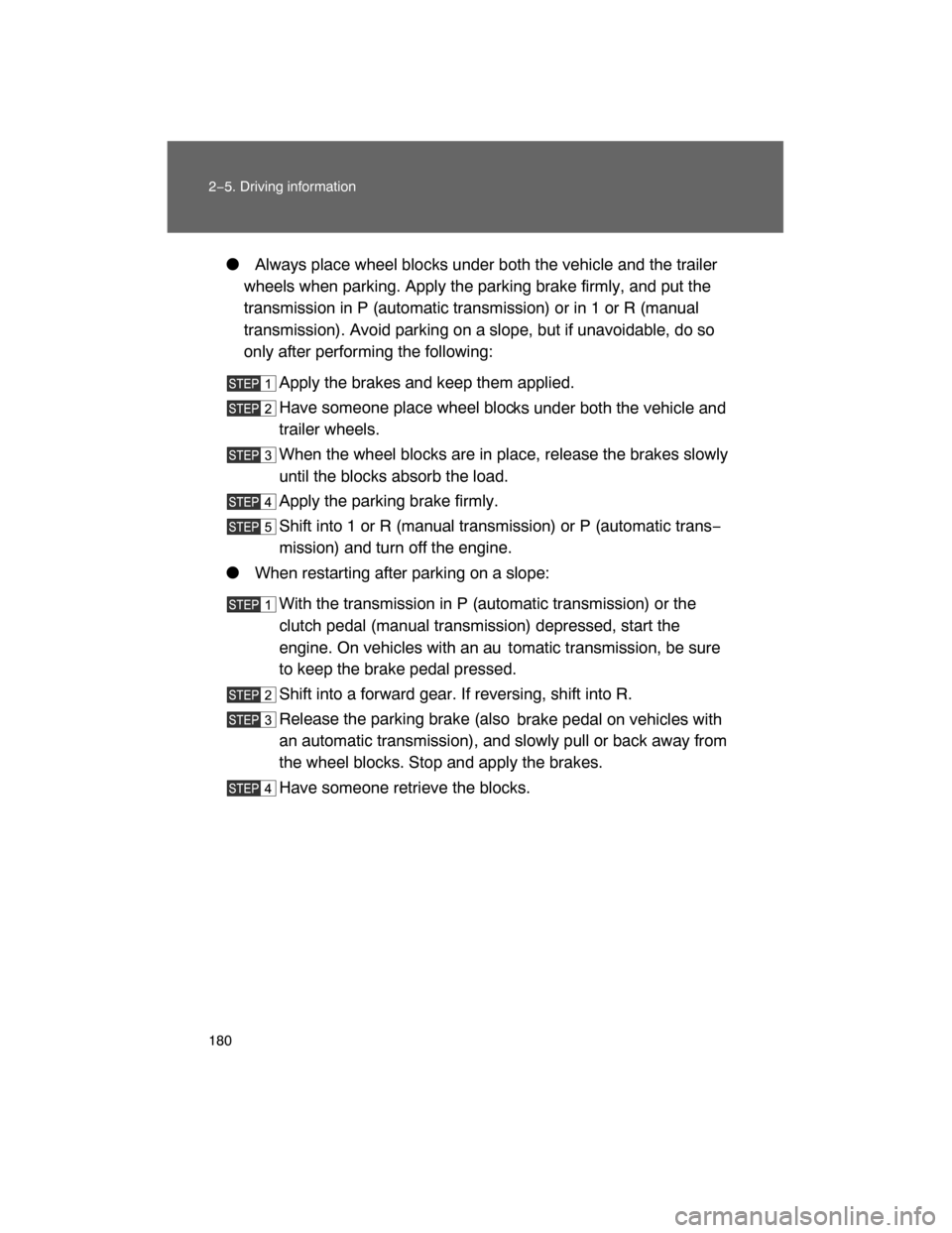Page 151 of 400

153
2−4. Using other driving systems
2
When driving
Manual transmission
Before using the rear differential lock system.
Shift the four−wheel drive control lever into LL to see if this is
sufficient. If this has no effect, additionally use the rear differ−
ential lock system.
Be sure to stop the wheels.
Depress the clutch pedal.
Press the RR DIFF LOCK switch.
After the rear differential is locked, the indicator will come on.
Slowly release the clutch pedal.
Unlock the rear differential as soon as the vehicle moves out.
To unlock the rear differential, push the switch again.
� Locking the rear differential
� When the rear differential is locked, VSC is automatically turned off.
(The rear differential lock and VSC OFF indicators come on.)
�The following systems do not operate when the rear differential is locked.
It is normal operation for the ABS warning light, VSC OFF indicator and
slip indicator to be on at this time.
�ABS
�Brake assist system
�VSC
�TRAC
� The rear differential lock is disengaged when
� Shift the four−wheel drive control lever to H or HL. (4WD models with a
manual transmission)
�Shift the front−wheel drive control lever to H2 or H4. (4WD models with
an automatic transmission)
Never forget to turn off the switch after using this feature.
�After unlocking the rear differential
Check the indicator go off, turn the engine switch to the ON position, but do
not start the engine.
Page 153 of 400
155
2−4. Using other driving systems
2
When driving
Clutch star t cancel switch (vehicles with a manual transmission)
� Clutch start system
The system is designed to keep the starter motor from operating if the clutch
pedal is not depressed all the way down. The switch allows the vehicle to be driven out of difficult situations
by cranking the engine with the clutch engaged.
Never use the switch for normal engine starting. Be sure to follow the
starting procedure. ( P. 114)
Press the CLUTCH START
CANCEL switch to cancel the
clutch start system with the
engine switch is turned to the
ON position.
The indicator comes on when
the clutch start system is can−
celed.
The clutch start cancel switch
is automatically turned off
when the engine switch is
turned off.
Page 155 of 400
157
2−4. Using other driving systems
2
When driving
To disable VSC
If the vehicle gets stuck in fresh snow or mud, VSC may reduce
power from the engine to the wheels. You may need to turn the sys−
tem off to enable you to rock the vehicle in order to free it.
Vehicles with rear differential lock system
Press the RR DIFF LOCK
switch.
The rear differential lock and VSC
OFF indicators should come on.
Push the switch again to turn the
system back on.
4WD models with an automatic transmission
Shift the front−wheel drive control
lever to H4 or L4.
The four−wheel drive and VSC
OFF indicators should come on.
Shift the lever to H2, turn the sys−
tem back on.
4WD models with a manual transmission
Shift the four−wheel drive control
lever to HL or LL.
The center differential lock and
VSC OFF indicators should come
on.
Shift the lever to H, turn the sys−
tem back on.
Page 162 of 400

164 2−5. Driving information
NOTICE
� To prevent the water damage
� Take all necessary safety measures to ensure that water damage to the
engine or other components does not occur.
Water entering the engine air intake will cause severe engine damage.
�Water entering the automatic transmission will cause deterioration in shift
quality, locking up of your transmission accompanied by vibration, and ulti−
mately damage.
� Water can wash the grease from wheel bearings, causing rusting and pre−
mature failure, and may also enter the differentials, transmission and
transfer case, reducing the gear oil’s lubricating qualities.
� When you drive through water
If driving through water, such as when crossing shallow streams, first check
the depth of the water and the bottom of the river bed for firmness. Drive
slowly and avoid deep water.
� Inspection after off�road driving
� Sand and mud that has accumulate
d in brake drums and around brake
discs may affect braking efficiency and may damage brake system compo−
nents.
� Always perform a maintenance inspection after each day of off−road driv−
ing that has taken you through rough terrain, sand, mud, or water. For
scheduled maintenance information, refer to the “Scheduled Maintenance
Guide” or “Owner ’s Manual Supplement”.
Page 168 of 400

170 2−5. Driving information
Regulations on the use of snow chains
� Regulations regarding the use of tire chains vary according to loca−
tion and type of road. Always check local regulations before install−
ing chains.
� Install the chains on the rear tires.
�
Retighten the chains after driving 1/4 − 1/2 mile (0.5 − 1.0 km).
� Snow chain installation
Observe the following precautions when installing and removing chains.
�Install and remove tire chains in a safe location.
�Install tire chains on the rear tires only. Do not install tire chains on the
front tires.
� Install tire chains following the instructions provided in the accompanying
instructions.
� When driving the vehicle
Accelerate the vehicle slowly and drive at a reduced speed suit−
able to road conditions.
� When parking the vehicle
Park the vehicle and move the shift lever to P (automatic trans−
mission) or to 1 or R (manual transmission) without setting the
parking brake. The parking brak e may freeze up, preventing it
from being released.
Page 177 of 400

179
2−5. Driving information
2
When driving
� Note that when making a turn, the trailer wheels will be closer than
the vehicle wheels to the inside of the turn. Compensate by making
a larger than normal turning radius.
� Crosswinds and rough roads will adversely affect handling of your
vehicle and trailer, causing sway . Periodically check the rear to
prepare for being passed by large trucks or buses, which may
cause your vehicle and trailer to sway. If swaying occurs, firmly grip
the steering wheel, reduce speed immediately but gradually, and
steer straight ahead. Never increase speed. If you make no
extreme correction with the stee ring or brakes, your vehicle and
trailer will stabilize.
�Take care when passing other vehicles. Passing requires consider−
able distance. After passing a vehicle, do not forget the length of
your trailer, and be sure you hav
e plenty of room before changing
lanes.
�
In order to maintain engine braking efficiency, do not use the trans−
mission in D (automatic transmiss
ion) or 6 (manual transmission).
� Due to the added load of the trailer, your vehicle’s engine may
overheat on hot days (at temperatures over 85°F [30°C]) when
driving up a long or steep grade. If the engine coolant temperature
gauge indicates overheating, immedi
ately turn off the air condition−
ing (if in use), pull your vehicle off the road and stop in a safe spot.
(
P. 356)
Page 178 of 400

180 2−5. Driving information
� Always place wheel blocks under both the vehicle and the trailer
wheels when parking. Apply the parking brake firmly, and put the
transmission in P (automatic transmission) or in 1 or R (manual
transmission). Avoid parking on a slope, but if unavoidable, do so
only after performing the following:
Apply the brakes and keep them applied.
Have someone place wheel bloc
ks under both the vehicle and
trailer wheels.
When the wheel blocks are in place, release the brakes slowly
until the blocks absorb the load.
Apply the parking brake firmly.
Shift into 1 or R (manual transmission) or P (automatic trans−
mission) and turn off the engine.
� When restarting after parking on a slope:
With the transmission in P (automatic transmission) or the
clutch pedal (manual transmission) depressed, start the
engine. On vehicles with an au tomatic transmission, be sure
to keep the brake pedal pressed.
Shift into a forward gear. If reversing, shift into R.
Release the parking brake (also
brake pedal on vehicles with
an automatic transmission), and slowly pull or back away from
the wheel blocks. Stop and apply the brakes.
Have someone retrieve the blocks.
Page 226 of 400
229
3−4. Using the storage features
3
Interior features
Cup holders (front)
Vehicles with an automatic transmission
CAUTION
� Caution while driving
Keep the glove box closed.
Injuries may result in the event of an accident or sudden braking.
Glove box and Cup holders (front)